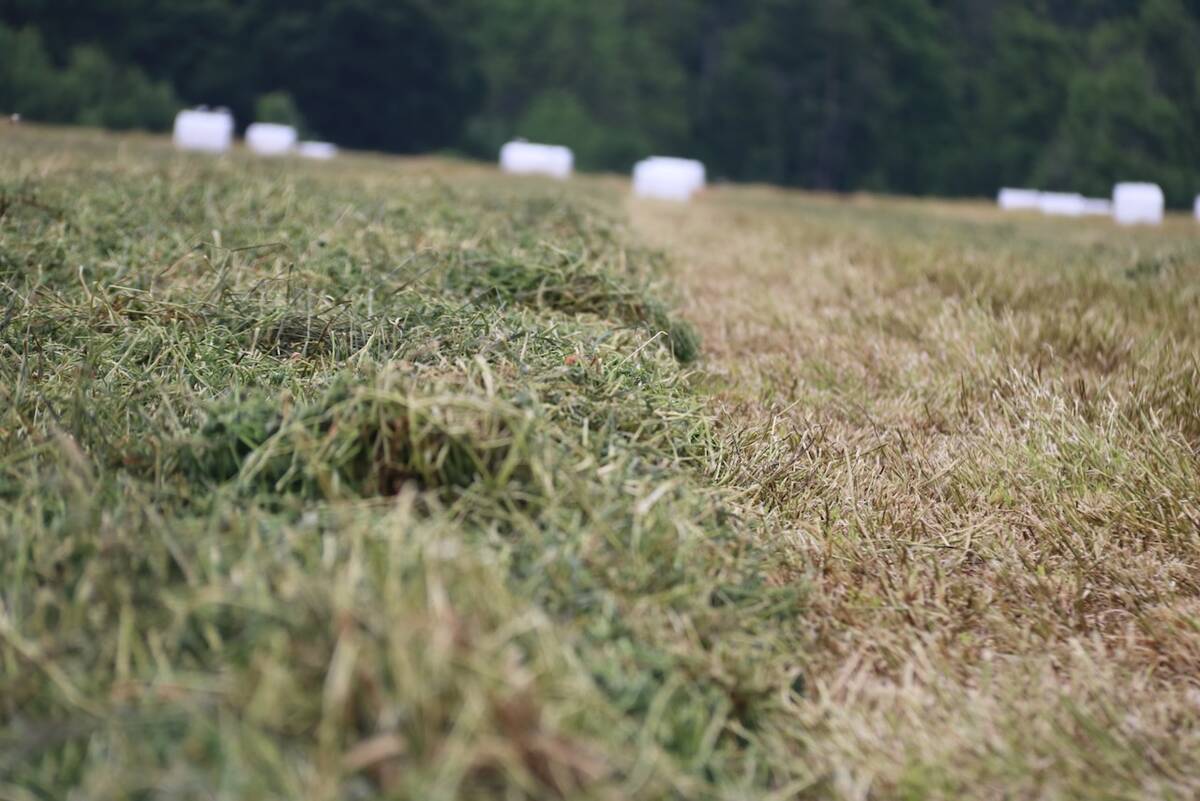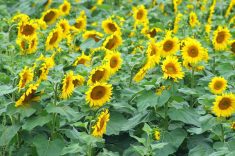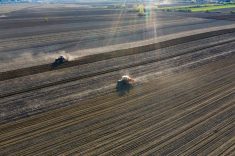Many farmers are dealing with seed infected with fusarium head blight (FHB). This four-step management plan can help keep it under control
When farmers pick up their cereal seed this year, what’s on their mind will largely depend on where they live, especially when it comes to concerns about fusarium head blight (FHB).
Fusarium on the Prairies
In Alberta, farmers purchasing seed from retailers can be confident that seed is not infected with Fusarium graminearum, the species of fusarium which is of most concern. F. graminearum produces mycotoxins, such as deoxynivalenol (DON), also known as vomitoxin, in the finished grain.
Alberta, where FHB caused by F. graminearum is largely localized, mainly to areas in the south, has a Fusarium graminearum Management Plan in place, which recommends testing of all cereal seed for the presence of this particular FHB pathogen. Any seed testing positive for F. graminearum cannot be sold in the province.
Read Also

New high-performance forage training program to launch in 2026
A new Canadian Forage and Grasslands Asssociation high-performance forage program will be a resource for farmers, agronomists and others in the forage sector.
In Manitoba, where FHB is endemic, farmers are less worried about whether seed is infected than they are about managing the disease in the field. However, infected seed may still present challenges in relation to seed germination and stand establishment.
Saskatchewan farmers probably face the biggest dilemma, as they had unprecedented levels of FHB in 2012. “They are looking at what can they do with severely infected seeds,” says Jeannie Gilbert, a cereal pathologist with the Cereal Research Centre in Winnipeg. “Most of them have never dealt with FHB before and now they suddenly need information. For example, if they use infected seed for their next crop what is it going to do?”
Farmers should first be aware of the situation they are facing in their own fields, says Kelly Turkington, a research scientist with Agriculture and Agri-Food Canada at Lacombe, Alta.
“If they are in an area where the information indicates that F. graminearum has been found frequently, they may not need to be too cautious about the seed sources they are looking at, given that the pathogen is already well established on infested crop residues. However, they should be concerned about quality in relation to seed germination and stand establishment and use a seed treatment to improve these,” says Turkington.
If a farmer is in an area where F. graminearum has not been found and/or is reported infrequently, then introducing the pathogen on infected seed is a concern. “In this situation producers should consider testing the seed they are planning on using and only using it if the pathogen is not detected in the sample tested, and then also treat it with a suitable seed treatment,” he adds.
Fusarium damaged kernels
The presence of fusarium damaged kernels (FDK) in cereal grain samples can cause them to be downgraded or rejected at the elevator, but those kernels may not always be damaged due to FHB.
“We have seen in many areas of western Saskatchewan and central and northern Alberta that producers will go to the elevator and take grain in and it will be graded as having FDK, and inevitably those FDK are not due to F. graminearum,” says Turkington.
“They are due either to other species of fusarium that are not as big a concern as far as toxin production, or they are due to a totally different pathogen like glume blotch in wheat.”
Turkington suggests that if grain is graded as having FDK at the elevator, farmers should get it tested to determine what is causing the FDK, particularly if FHB caused by F. graminearum hasn’t been a frequent or widespread problem in that growing area. That said, studies have shown that fusarium-infected grain may have decreased seedling emergence and tillering, so it’s important not to plant seed with high levels of fusarium (even if it’s not F. graminearum) and/or to use a seed treatment.
Four-step management plan
A management plan for the disease is probably the most important thing for most cereal growers to consider, regardless of whether they have had problems with FHB or not. “It’s all about prevention, because once you establish the F. graminearum pathogen you’ve got it [forever],” says Kevin Zaychuk, business development manager for 20/20 Seed labs in Alberta. “It’s hard to keep that in the forefront of a producer’s mind when there are so many other issues to deal with. It’s always important that producers know about the pathogen and how to manage it.”
Here are four areas to include in your management plan.
1. Seed treatments. Seed treatments are an important tool to help improve seedling growth and stand establishment. There are many available on the market and most are fairly effective against the pathogen. Fusarium causes seedling blight, which reduces stands and this can seriously jeopardise yields, especially under warm, moist conditions that are conducive to the development of the disease. Unfortunately, seed treatments may not be able to completely eradicate the pathogen from infected seed, so using them alone will not completely eliminate the risk of introducing F. graminearum into areas where this pathogen is not present or frequently found.
Seed treatments will not prevent FHB from developing later in the season from stubble-borne disease inoculum in regions where fusarium species are already established. Research has shown that a foliar fungicide application is recommended in FHB-endemic regions when warm, wet conditions prevail after head emergence, disease forecasting indicates that conditions are favourable for disease development, and the expected yield return justifies the cost of application.
2. Good seed quality. Good seed quality is essential. Commercial seed laboratories can test cereals to determine the percentage and species of fusarium in seed intended for planting. It’s not recommended that F. graminearum infected seed be planted in regions where the species is not already established. Seed infected with F. graminearum can be planted back into regions where this species is established, because infected residue will already be present in that area. If the level of seed infection is high, there may be problems with seed germination, seeding emergence and stand establishment. Seed testing laboratories can help to provide guidance in relation to seed quality concerns.
If seed is being tested for the presence of fusarium it should also be tested for germination and vigour. If both of these are high plants should get off to a good start even though there may be some seed infection present, but it may also be useful to use a seed treatment as added insurance against impacts on germination and emergence.
3. Resistant varieties. There are currently no varieties available that offer complete resistance to FHB, but durum and CPS wheat are the most susceptible to FHB. Winter wheat is susceptible, but can escape infection because it is flowering before fusarium spores are present. Barley is generally less susceptible than wheat, and oats are the least susceptible.
Resistant varieties still remain the number one defence against FHB. Research has shown that varieties that are more tolerant to FHB respond better to fungicide treatment and to fungicide application at the heading stage but they also give an immediate advantage in terms of reducing the amount of fusarium that will be present in the crop should the season turn out to be prime for infection, says Gilbert. “If there is some genetic resistance the cereal crop will be able to resist the pathogen and so right there you have an edge,” she says.
4. Crop rotation. Good crop rotation provides another edge. Planting cereals into corn or cereal residue is inviting more problems than following cereals with a pulse or alfalfa crop, because the fusarium pathogen survives in crop residue. If at all possible breaking up the disease cycle by planting non-host crops will help reduce the build up of spores.
“There often is a complete and total focus on the seed end of things; testing it and treating it,” says Turkington. “But if you want to limit introduction or if there is an inadvertent introduction from a neighbour’s field and you want to limit build up of the pathogen, you need to look at extending your rotation. Often that’s not considered as part of the overall approach to minimise the risk of the pathogen becoming an issue. At least two years of a non-host crop between cereals would be useful to help to break the disease cycle.”
If producers are really concerned about FHB and want to tweak their surveillance program for the disease Turkington suggests testing residue. “Take samples of the lower stem nodes on the plant stem and send those in to the seed testing lab,” he says. “The fungus might be in the residue but if conditions at flowering and later are dry it doesn’t move from the residue up onto the head. But it might move up into the rest of the canopy where there is more humidity that is more conducive to the pathogen.”
Data from trials in North Dakota conducted in 2008 indicate that the most promising results obtained in managing FHB integrated various strategies that included resistant varieties, crop rotation and fungicide applications.
While the product in the seed bag is important, and ensuring viable, good quality seed is the starting point, considering other management options to reduce the potential for FHB and protect yield will likely also be on the minds of farmers this spring. †















